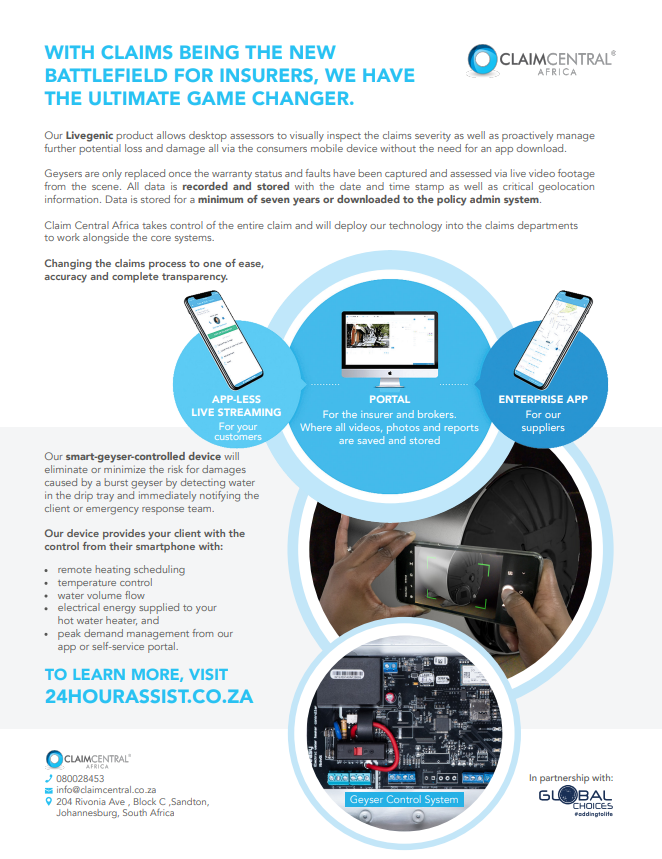Wimpie van Der Merwe (CEO, Global Choices)

Today’s customers – and those of the future – want more than just protection through an insurance product. In the new digital age, customers view their insurance as an amalgamation of the risk product, value-added services, and customer experience to create the total experience.
They want insurers to help prevent and detect loss incidents through value-added services and digital capabilities, to avoid traumatic scenarios. They seek empathic insurers who help them manage their lives across a broader array. They want next-gen, customer-centric insurers who prioritise customer-facing applications and protocols to redefine the experience to create a holistic experience across not only the value chain but also with ecosystem partners who bring value to this relationship.
Make allowances for digital natives
Millennials and Gen Zers increasingly expect seamless, omnichannel, multi-channel, and real-time interactions integrated with the digital platforms they already use. Insurers will need to balance the needs of this new and younger generation with those of older ones, including the Gen Xers and baby boomers who do not have the same preferences or aptitude with digital interactions. Also remember that the customer and employee demographic combination will change dramatically between now and 2030 when digital natives will make up half of the adult population.
The power of loss prevention and protection
Insurers can provide advantages to their customers by helping them to avoid making claims. Insurance companies have a strategic choice to make on whether to raise policy prices to combat inflation or to work at strategies, products, and services to prevent claims frequency. Inflation is driving up the cost of claims for insurers. We are seeing a gradual shift (in my opinion, not fast enough!) from risk management to risk prevention. This shift is transforming the relationship between insurer and insured to one of symbiosis, where both parties depend on and receive beneficial reinforcement.
Reimagine the insurer’s role
Reimagining the insurer’s role where AI-enabled and digital tools create more capacity in claims departments, insurers will have the ability to further differentiate themselves by dedicating additional resources to claim prevention. Preventing claims before they occur will fundamentally change the relationship between insurers and customers from one focused on accidents or losses, to a partnership with a mutual interest in loss prevention. This shift also positions insurers to transition from a risk transfer model to a risk and claims mitigation model. In the future, telematics will be coupled with sensor-equipped and smart devices for home security, water meters, geysers, fire prevention and motor vehicles, among others. Added to this will be third-party data from traffic cameras, road safety organisations and weather forecasts to alert customers and would-be claimants to emerging risks before losses occur. With this new explosion of data sources, insurers can adopt strategies like predictive maintenance and behaviour incentivisation to encourage risk-reducing behaviours.
Creating value
Embracing the wider digital ecosystem, where insurers operate and use innovative technologies, creates value across the entire claims value chain. New tech partnerships will fill gaps in data science, loss prevention, machine learning and artificial intelligence (AI).
All of this is possible today, which makes it entirely reasonable to imagine these scenarios playing out by 2030 — as long as insurers can drive customer adoption to create the economies of scale that will make it viable. Innovation can accelerate throughout the insurance ecosystem where insurers, insurtech, OEMs (original equipment manufacturers of geysers, smoke detectors, security components, tracking companies, etc.), information providers (like weather, traffic and security), law firms, AI, IoT solutions providers, and data aggregators push the boundaries.
In this new age claims ecosystem, third-party infrastructure — such as street cameras, telematics and sensors built into cars, as well as wearable devices and machines — will give insurers automated access to uncomplicated facts of the loss. Their customer can also provide, live videos from their mobile phones, streaming communication and photos that can be recorded to assist insurers with vital visual information from risk events. With the right analytics tools, insurers will be able to determine liability very quickly and make more accurate appraisals and damage assessments. This will move claims faster from submission to settlement.
Expanding the claims ecosystem will also enable insurers to move beyond traditional claims activities into adjacent and aligned businesses to access customers earlier and deepen customer relationships. For example, an insurer can expand into claims prevention via a detailed home risk assessment; with assistance to repairs and annual maintenance programmes as part of their value proposition, they can educate customers around potential elevated risk areas or safety concerns at their homes. Insurers can even assist potential customers with assisted risk inspections/assessments reports of a new home’s hidden risk before they buy it – like weather, floods, fire, structural issues, pest infestation, maintenance issues, crime and security in the residential area.
Insurers can unlock a bigger, more noble purpose and value in the industry, creating new value for their own companies, by reimagining and expanding their role beyond that of risk provider to become an integrator of measurement and control applications that gather data and insights from countless third-party providers and technologies. Achieving this new integrator role will be a challenge as it will require a targeted strategy and the co-operation of other qualified ecosystem participants, such as providers of claims management systems. The insurers who succeed will attain a competitive advantage by owning access to sought-after data and information.
To achieve this claims mitigation and integrator ecosystem vision, insurers will need to invest in innovative technologies and ultimately commit to a proactive and human-centred customer service experience.


